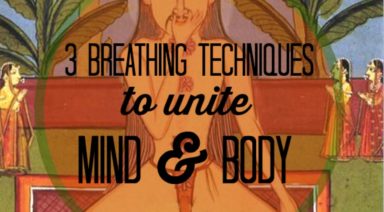10 Fun Facts About Breathing & the Respiratory System

Our ability to breathe is fascinating, as it’s one of the only systems in our body that can be controlled both voluntarily, through the central nervous system, and more often involuntarily, through the autonomic nervous system. This overlap between the two systems is the reason why focused, intentional breathing methods through yoga and meditation are able to affect other involuntary muscles like the heart.
Our breath is what gives us life and without it, the human body cannot exist. But is it possible to better your life by paying more attention to how you breathe?
While breathing is so commonplace to our existence, proper breathing techniques and awareness of breath can have dramatic implications on our health. Having knowledge of specific breathing techniques can lower stress, help you sleep, help your mind function more acutely, and even curb food cravings.
When we breathe, the average adult draws in about 13 pints of air into the lungs every minute. From the lungs, that oxygen is then transferred from the air sacs in our lungs throughout the body via red blood cells to the blood vessels that distribute it to nearly every system. Meanwhile, waste gases, like CO2, are exchanged and filtered out.
For the average person with good lung health, the amount of oxygen in the blood, or the arterial blood gas (ABG) oxygen level, should be somewhere between 95-100 percent oxygen.
Interesting Facts About Breathing
1. Breathing is the only autonomous system of the body that we can also control. This means that the body governs it, but we can change how we breathe through conscious breathing practices such as pranayama.
2. If you laid out the lungs flat, they would cover the size of a tennis court (about 70 square meters!) The right lung is larger than the left: The left lung is made up of two lobes while the right is made up of three.
3. When we breathe we are either right nostril or left nostril dominant. You can find out which is more active by wetting your thumb and holding it to the right then the left nostril. Yogis believe that when the right is more open or breathing more smoothly we are more driven by the sympathetic nervous system. This means we are more fired up, active, and aroused. Dominance in the left nostril tends to happen when we are relaxed and at ease. The dominance changes around every 20 minutes during the day. Single-nostril breathing can help regulate the left and right sides thereby creating balance in our nervous system.
4. Breathing more slowly and taking longer breaths can reduce your appetite according to some studies. While mindfulness techniques like visualization and guided imagery have shown to be highly effective for those struggling with food cravings and addiction, slow breathing exercises also proved effective.
5. It is normal to take around 16 breaths per minute. Asthmatics and people who hyperventilate often double this breathing rate. This leads to taking in more oxygen but expelling too much carbon dioxide, or CO2. When your CO2 is decreased you can’t get as much oxygen setting up a cycle whereby you breathe even faster.
6. Ancient yogis believed we only have so many breaths in our life. It’s considered within a normal range to take somewhere between 12 to 25 breaths per minute, based on your level of fitness. But the average person takes about 16 breaths per minute, or 960 breaths per hour, 23,040 breaths a day, 8,409,600 a year. If you lived to the age of 75, that would mean 630,720,000 breaths in your lifetime.
But if we could, why not stretch our life span out a bit longer by taking as many slow, deep breaths as possible?
7. Our breath is an indicator of our mood and our mood is an indicator of our breath. This means that if we change how we breathe we can change our mood. It also means that when our mood changes so does our breath. When it comes to stress, mindful breathing practices are a great tool to lower blood pressure, increase our lung capacity for oxygen, and in the long term, prevent heart disease.
Our brains are always reacting to situations based on our fight-or-flight mechanism, an inherent survival mechanism that surely protected us from fatal situations that occurred often in our more primitive days. In modern society, that mechanism still exists and our brains tend to apply it to the daily stresses of life that aren’t so life-threatening. With that, unfortunately, comes the stress response spiking cortisol and other stress hormones, which when released too often, can lead to chronic fatigue, depression, and disease. But don’t just take our word for it, check out Harvard Medical School’s research backing it.
8. There are some common breathing habits that we have that we may not even know about. They are the following:
-
- Only breathing into the chest
- Inhalations are stronger than exhalations
- Breath-holding
- Mouth breathing
- Reverse breathing (where the diaphragm rises instead of falls on the inhale)
- Over-breathing
9. We breathe in and out of our nose during a yoga practice for a few reasons. The main one is that when we breathe like this we can’t take in so much air or expel so much air. So if we have to resort to opening our mouth to get more air it is an indicator that we have stepped into stressing or pushing our bodies.
10. Mouth-breathing can contribute to the following:
-
- Misaligned bite
- Bad breath
- Snoring
- Sleep apnea
- Night-time urination
With the increasing research we have, showing the importance of breath and breathing habits, it’s becoming more and more clear that being mindful of your breath is incredibly beneficial to your overall health and wellbeing. So if you haven’t already, try practicing some mindful breathing techniques and watch how quickly the various systems of your body begin to respond.
How to Create a Meditation Altar

In The Miracle of Mindfulness, Zen Master Thich Nhat Hanh says that we should meditate because “each of us needs to realize total rest…mindfulness is the miracle by which we master and restore ourselves.” Sometimes, even a full night’s sleep doesn’t help you achieve total rest. How can the restless truly rest in modern society? Mindfulness, or the art of living in the present moment, is an important state of being to achieve in such a busy world. It’s not only good for your overall well-being, but it’s also an excellent way to practice self-love. Discover how to make a meditation altar designed for your specific spiritual practice.
1. Develop a Daily Meditation Practice
As we rush through life, many of us feel like we’re not quite present in every moment. According to Karen Kissel Wegela, Ph.D., to counter this feeling, practice mindfulness meditation. Meditation allows you to let go when stressed and accept yourself just as you are – your thoughts, feelings, and emotions as they arise from moment to moment.
It is important to have a meditation practice that grounds and centers you daily. Such a practice will allow you to feel strongly connected to and centered with yourself. Sometimes, breathing exercises aren’t enough. You need a physical place to go to and rest. While mindfulness meditation can be practiced anywhere, having a sacred space to call your own is important. An altar is a beautiful space full of sacred energy that you can tap into when you need it. Anyone can create an inspirational altar with just a few items and pure intention.
















